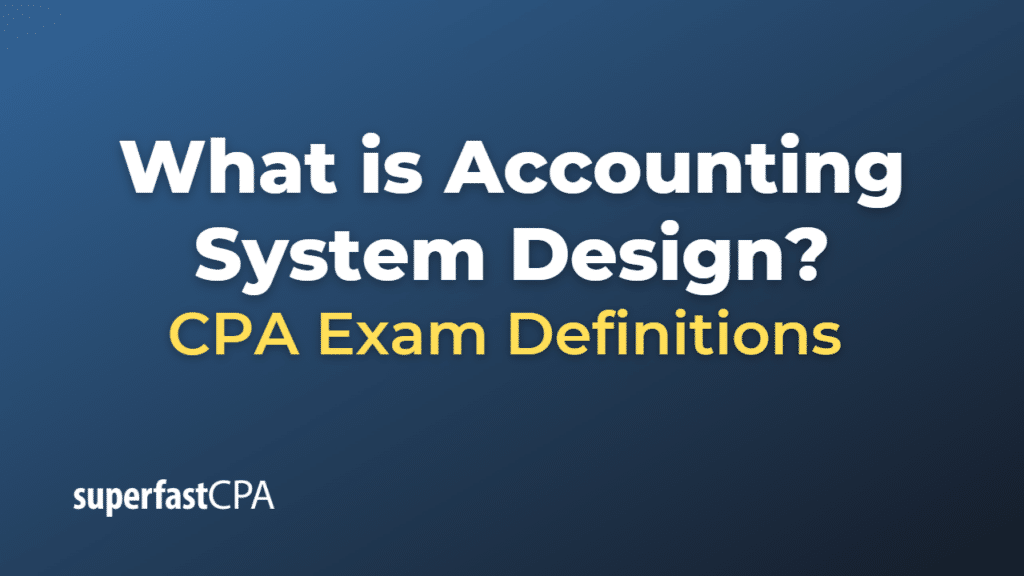Accounting System Design
Accounting system design refers to the process of planning, developing, and implementing an accounting system tailored to meet the specific needs of an organization. This process involves identifying the organization’s financial reporting requirements, defining the components of the accounting system, and ensuring that the system is user-friendly, efficient, and compliant with applicable accounting standards and regulations. A well-designed accounting system is essential for maintaining accurate financial records, supporting effective decision-making, and promoting the overall financial health of the organization.
Key steps involved in the design of an accounting system include:
- Assessing the organization’s needs: Determine the specific financial reporting and management requirements of the organization, considering factors such as the nature of the business, its size, industry, and regulatory environment.
- Selecting the appropriate accounting method: Choose between cash-basis, accrual-basis, or a hybrid accounting method, based on the organization’s needs and reporting requirements.
- Designing the chart of accounts: Develop a comprehensive list of accounts tailored to the organization’s financial transactions and reporting needs. The chart of accounts should be organized into categories such as assets, liabilities, equity, revenues, and expenses.
- Establishing a journal and ledger structure: Design the system of journals and ledgers for recording and summarizing financial transactions, including the general journal, special journals, general ledger, and subsidiary ledgers.
- Implementing internal controls: Develop policies and procedures to safeguard the organization’s assets, ensure the accuracy and reliability of financial information, and promote compliance with laws and regulations.
- Selecting accounting software or tools: Choose appropriate accounting software or tools that meet the organization’s needs, budget, and technical requirements. This can range from simple spreadsheets to advanced accounting software or enterprise resource planning (ERP) systems.
- Customizing and configuring the system: Set up and configure the accounting system, tailoring it to the organization’s unique needs and requirements. This may involve customizing the chart of accounts, defining reporting formats, and setting up workflows and approval processes.
- Integrating the system with other business processes: Ensure that the accounting system interfaces seamlessly with other business systems, such as inventory management, payroll, and customer relationship management (CRM) systems.
- Training users: Provide training to the organization’s staff on how to use the accounting system effectively and efficiently.
- Monitoring and maintaining the system: Regularly review the performance of the accounting system, identify areas for improvement, and implement necessary updates or changes.
Designing an effective accounting system requires careful planning, analysis, and customization to ensure it meets the organization’s needs and supports efficient financial management and reporting.
Example of Accounting System Design
Let’s consider a fictional small manufacturing company, “Gadget Producers Inc.,” that wants to design a new accounting system to better manage its financial transactions and reporting. The following example outlines the key steps involved in designing the accounting system for Gadget Producers Inc.:
- Assessing the organization’s needs: Gadget Producers Inc. needs an accounting system that can handle inventory management, cost accounting, sales and purchase transactions, and financial reporting.
- Selecting the appropriate accounting method: The company chooses the accrual-basis accounting method to provide a more accurate representation of its financial performance and position.
- Designing the chart of accounts: Gadget Producers Inc. creates a chart of accounts that includes categories such as assets, liabilities, equity, revenues, and expenses. Specific accounts are created for cash, accounts receivable, inventory, accounts payable, sales revenue, cost of goods sold, and various operating expenses.
- Establishing a journal and ledger structure: The company sets up a general journal for recording non-routine transactions and special journals for routine transactions like sales, purchases, and cash disbursements. A general ledger is created to summarize all financial transactions, along with subsidiary ledgers for accounts receivable, accounts payable, and inventory.
- Implementing internal controls: Gadget Producers Inc. establishes internal controls, such as separation of duties, regular inventory counts, and periodic bank reconciliations, to safeguard assets and ensure accurate financial reporting.
- Selecting accounting software or tools: The company decides to use an accounting software like QuickBooks or Xero, which offers inventory management, cost accounting, and financial reporting features tailored to the needs of a small manufacturing business.
- Customizing and configuring the system: Gadget Producers Inc. sets up and customizes the software, including creating a customized chart of accounts, defining reporting formats, and configuring workflows and approval processes.
- Integrating the system with other business processes: The accounting system is integrated with other business systems, such as the company’s payroll system and customer relationship management (CRM) software.
- Training users: Gadget Producers Inc. provides training to its staff on how to use the new accounting system effectively and efficiently.
- Monitoring and maintaining the system: The company regularly reviews the performance of the accounting system, identifies areas for improvement, and implements necessary updates or changes.
In this example, the design and implementation of a new accounting system help Gadget Producers Inc. manage its financial transactions and reporting more effectively, providing accurate and timely information for decision-making and compliance with accounting standards and regulations.













